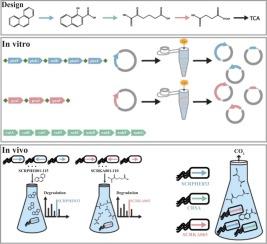利用SCRaMbLE促进关键基因进化的综合工程大肠杆菌群对菲的降解
IF 11.3
1区 环境科学与生态学
Q1 ENGINEERING, ENVIRONMENTAL
引用次数: 0
摘要
菲是一种普遍存在的多环芳烃(PAH),由于其持久性和生物蓄积性,对环境和健康构成重大风险。本研究提出了一个由三种工程大肠杆菌BL21(DE3)菌株组成的合成细菌联合体,每个菌株都含有由pET-28(a)质粒编码的不同分解代谢模块,用于菲的完全矿化。该联盟是通过整合17个对菲降解至关重要的基因而设计的,这些基因被组织成三个不同的模块,利用不同菌株的集体代谢潜力来增强降解过程。每个模块都针对菲分解代谢的特定阶段量身定制,确保污染物的协调和有效分解。在上游和下游降解模块中鉴定出限速酶后,使用SCRaMbLE方法对8个相应基因进行实验室进化,以增强菌株的降解能力。然后在含有100 mg/L菲的微量盐培养基(MSM)中对该联合体进行测试。经过进化,两株SCRaMbLE菌株E. coli SCRPHE033和E. coli SCRKA065对各自底物的降解率分别提高了11.5和25.18%。最后,对由2株SCRaMbLE菌株和大肠杆菌CRSA组成的菲综合降解体系进行了综合优化,在120小时内对100 mg/L菲的降解效率达到了84.33%。该研究显示了合成生物学在构建基于SCRaMbLE方法的环境生物修复微生物群落方面的潜力,为减轻多环芳烃污染提供了一种有希望的策略。本文章由计算机程序翻译,如有差异,请以英文原文为准。

Enhanced Phenanthrene Degradation by a Synthetically Engineered E. coli Consortium Utilizing the SCRaMbLE for the Evolution of Key Genes
Phenanthrene, a pervasive polycyclic aromatic hydrocarbon (PAH), poses significant environmental and health risks due to its persistence and bioaccumulation. This study presents the development of a synthetic bacterial consortium comprising three engineered Escherichia coli BL21(DE3) strains, each harboring distinct catabolic modules encoded by pET-28(a) plasmids for the complete mineralization of phenanthrene. The consortium was engineered by integrating 17 genes critical for phenanthrene degradation, organized into three distinct modules that harness the collective metabolic potential of separate strains to enhance the degradation process. Each module was tailored to a specific phase of phenanthrene catabolism, ensuring the coordinated and efficient breakdown of the pollutant. Following the identification of rate-limiting enzymes within the up- and downstream degradation modules, the eight corresponding genes were subjected to laboratory evolution using the SCRaMbLE method to bolster the degradation capabilities of the strains. The consortium was then tested in a minimal salt medium (MSM) containing 100 mg/L phenanthrene. Following their evolution, the two SCRaMbLE strains E. coli SCRPHE033 and E. coli SCRKA065 exhibited enhanced degradation rates of 11.5 and 25.18% for their respective substrates. Finally, the comprehensive phenanthrene degradation system, which includes the two SCRaMbLE strains and E. coli CRSA, was subjected to comprehensive optimization, after which it achieved a significant degradation efficiency of 84.33% for 100 mg/L phenanthrene within a 120-hour timeframe. This research demonstrates the potential of synthetic biology in constructing microbial consortia for environmental bioremediation based on the SCRaMbLE method, offering a promising strategy for mitigating PAH pollution.
求助全文
通过发布文献求助,成功后即可免费获取论文全文。
去求助
来源期刊

Journal of Hazardous Materials
工程技术-工程:环境
CiteScore
25.40
自引率
5.90%
发文量
3059
审稿时长
58 days
期刊介绍:
The Journal of Hazardous Materials serves as a global platform for promoting cutting-edge research in the field of Environmental Science and Engineering. Our publication features a wide range of articles, including full-length research papers, review articles, and perspectives, with the aim of enhancing our understanding of the dangers and risks associated with various materials concerning public health and the environment. It is important to note that the term "environmental contaminants" refers specifically to substances that pose hazardous effects through contamination, while excluding those that do not have such impacts on the environment or human health. Moreover, we emphasize the distinction between wastes and hazardous materials in order to provide further clarity on the scope of the journal. We have a keen interest in exploring specific compounds and microbial agents that have adverse effects on the environment.
 求助内容:
求助内容: 应助结果提醒方式:
应助结果提醒方式:


